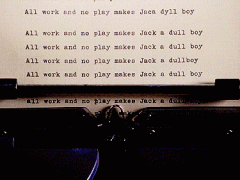A book, a day: The Visual History of Type by Paul McNeil
“A mind-blowing catalogue of typefaces and type history… a fantastic, heavyweight compendium of letterforms that’s a firm WIRED art department favourite” reads the WIRED review of this comprehensive, detailed survey of the major typefaces produced since the advent of printing with movable type in the mid-fifteenth century to the present day aka Paul McNeil's “The Visual History of Type” published by Laurence King.
In this publication the cofounder of MuirMcNeil arranges chronologically more than 320 typefaces to provide context and eventually the book is a significant resource for professional type designers and students of type, alike.
“A few years ago, I became aware of the absence of any definitive histories of type other than Jaspert, Berry and Johnson’s seminal Encyclopedia of Typefaces, which has been continuously in print since 1953, and Sutton And Bartram’s unsurpassed Atlas of Typeforms from 1968 — two books I hold in the highest regard” said McNeil.
“I wanted to fill that gap, not solely because of its usefulness in helping designers understand how and why type works but also because of the exceptional richness of its historical connections to technologies, to the aesthetic milieu of different eras and to processes of social and ideological evolution. Type is a microcosmic representation of culture.”
Featuring “fantastic discoveries like the 1922 Bremer Presse Antiqua and spectacular new ideas such as Sandrine Nugue’s Infini from 2015” and more the publication displays the type designs in the form of their original type specimens or earliest printing with each entry supported by a brief history and description of key characteristics of the typeface and the outcome is literally an “exhaustive portrait showing the evolution of typeface design,” covering over two centuries of the most important developments in the field.
A book, a day: Designing Programmes by Karl Gerstner
“Of the 320+ typefaces represented in the book many had to be included because they are canonical, ‘classic’ designs that have proven time and again to be effortlessly legible, versatile and unobtrusive; like Garamond or Caslon, for example. Because they have served generations of readers faultlessly, generations of printers and publishers have depended on them and they have become accepted as benchmarks of typographic excellence, efficiency and beauty. But one of the objectives of The Visual History of Type was to present a picture of the contemporary milieu of every era since the 1450s, so we also selected examples that only lasted a short while due to changes in fashion or technology, or that were purely experimental.”
“It’s inevitable that many of these choices might be contentious but they have all been chosen with care for their relevance to the historical narrative instead of those that some might deem more wholesome. A consistent theme running though The Visual History of Type is the evolving relationship of technology and ideology, from the mediaeval period through to the modern era – and to today, wherever we are now. The evolution of type seems to represent these cultural shifts very effectively in visual form.”
Seven years in the making and described by Wim Crouwel as ‘stunning’, this book is essential reading for type aficionados and enthusiasts alike.
Buy your own copy here.
Tags/ typography, type design, book, laurence king, muirmcneil






















